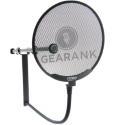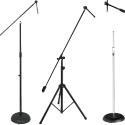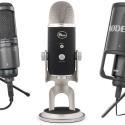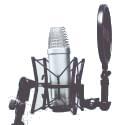What Does a Shock Mount Do to Improve Mic Performance?
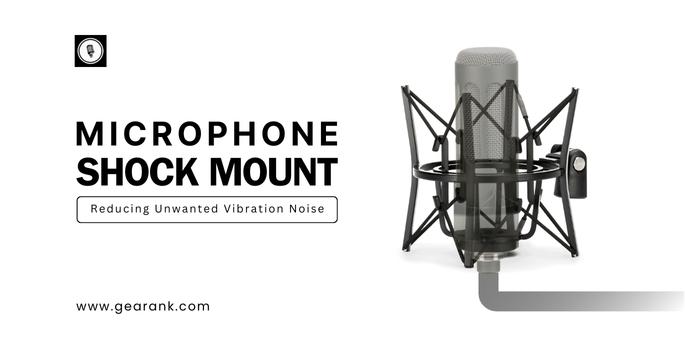
If you have ever been in a broadcasting or music studio, you might have come across a mic shock mount. But what does a shock mount do?
Shock mounts resemble a cat's cradle and are typically affixed to microphone stands or boom arms. They suspend the mic using elastic components (elastic suspension), thereby reducing vibration and handling noise that may affect the quality of your recording.
In this article, I will elaborate on microphone shock mounts and how they can enhance your recording quality.
Using a microphone shock mount can reduce the external noise your mic picks up, resulting in less mechanically transmitted noise in your audio. This means less editing work and higher-quality recordings.
How Is Sound Produced?
To produce sound, you require a source of sound waves and mechanical vibrations. Additionally, you need a receiver that can convert that source into electrical signals to be sent to recording equipment.
The Microphone
Microphones, specifically their diaphragms, detect sound waves or vibrations in the air and convert them into electrical signals transmitted to the recording device.
However, depending on their sensitivity, some microphones may also pick up unnecessary mechanical noise. These noises result from objects colliding against surfaces and other activities like moving equipment in the studio or handling the microphone while recording vocals.
Vibrations
Vibrations can produce audible sounds, but their duration is determined by the material properties of the medium they pass through.
Rigid materials restrict the amplitude of oscillations, while flexible materials allow larger amplitude oscillations.
Consequently, more energy is required to transmit vibrations through flexible materials. Conversely, loose and soft materials absorb more of the vibration's energy, depleting the vibrations more rapidly.
What Does a Shock Mount Do?
A shock mount, or isolation mount, is a device used to hold to isolate microphones from vibrations.
It works as a barrier between the microphone capsules and the gear holding it, such as a mic stand or boom arm.
The shock mounts' universal appeal is their ability to isolate microphones from vibrations.
Shock mounts work by using elastic bands that absorb the vibrations, preventing the microphone from picking up any mechanical noise caused by external interference.
For example, if you're broadcasting using a mic mounted on a stand clamped to a desk without shock, any vibrations, such as tapping or dropping your phone on it, will travel up toward the microphone.
However, before they reach the microphone, they first cross the shock mount, which weakens them significantly, preventing the microphone from picking them up. It attenuates the sounds caused by table tapping, microphone movements, button noises when you start recording, and more.
Without a shock mount, any interference caused by vibrations would reach the microphone capsule, resulting in unpleasant sounds that would reduce your audio broadcast or recording quality.
Do You Need a Shock Mount?
Despite its numerous advantages, there are several factors to consider before purchasing a shock mount.
Microphone Sensitivity
Microphone sensitivity is a crucial aspect to consider while choosing a microphone. Different microphones have varying sensitivity levels, with some being more sensitive than others.
Condenser microphones are highly sensitive and can detect even the slightest vibrations. Therefore, using a shock mount is necessary to reduce background noise or mechanical disturbances.
Dynamic microphones are less sensitive and less likely to pick up vibrations, so they usually do not require a shock mount.
If you are looking for the best microphone under $50, check which microphones require a shock mount and which don't.
Microphone Mounts
When choosing a microphone, it's important to consider the type of mount it comes with. Most microphone manufacturers offer mic stands with universal mounts, which allow you to attach or replace mic clips with shock mounts. Many mounts come with adapters for working with mics of different sizes.
Other shock mounts are built into the mic itself. Many condenser microphones come with built-in shock mounts that function as both vibration dampeners and shock absorbers, eliminating the need for an external shock mount.
However, if you have a condenser microphone that doesn't have a built-in shock mount, it may be worth investing in one. A good value mount includes other accessories like a pop filter, and various mounting clips and adapters.
Integrated Shock Mounts
Some microphones come equipped with an integrated shock mount, which makes them naturally better at handling noise. You won't need a shock mount when you have a microphone with an integrated shock mount.
Noisy Mic Stand
It might be time to replace your mic stand if it's unreliable or creaky. In the meantime, a shock mount can help reduce unwanted structure borne noise while you shop for a new stand. The mic cable can also be a cause of noise, so you should consider getting a cable clip.
Final Thoughts
It is essential to understand the role of a shock mount in reducing mechanically transmitted noise, especially in broadcasting and recording, where clear audio quality is crucial.
Knowing the answer to "What does a shock mount do?" is also important for recording setups since a shock mount isolates unwanted noises to ensure clear and high-quality audio.
The audio quality can be further optimized when combined with a microphone pop filter. This results in a clean recording, vital in broadcasting and recording environments.
A shock mount uses elastic bands and springs to remove excess vibrations that might affect the sound quality. When selecting a shock mount, choosing one that is affordable and won't restrict movement in tighter studio spaces is important. And proper its proper utilization is an important part of microphone basics and operation.
If you are starting your recording or broadcasting journey, it is highly recommended to consider using a shock mount. They are useful accessories that can significantly improve the sound quality of your recordings and broadcasts.
Frequently Asked Questions
Can You Record Without a Shock Mount?
Yes, it is possible, especially when using a less sensitive microphone such as a dynamic microphone. Moreover, in a quiet and well-treated environment, you can record with any microphone, even without a shock mount.
However, if you are in a less ideal environment with a sensitive microphone, having a shock mount will be very useful as it helps to reduce vibrations and produce better-sounding audio.
What Makes a Good Shock Mount?
A good quality shock mount can come in several forms, depending on your requirements. One essential aspect to remember is to buy a shock mount designed explicitly for your microphone.
Most shock mounts are not universal so that they won't work with any mic. While some may be compatible with a few different microphone types, they are generally custom-made for specific designs.
What Can Cause Mechanically Transmitted Interference?
Mechanically transmitted interference can be caused if any solid object connected to the microphone stand is struck or if the microphone is moved.
This can result in some unwanted sound artifacts being recorded or broadcasted. Low-frequency outside noise can also trigger it, although low-level noise should not be a problem.
You may add effects while recording the tracks depending on your or the artist's preferences. This can also help with overdubbing, improving performance, and providing a sense of comfort.
Contributors:
- Jerome Arcon - Co-writer
- Jerry Borillo - Illustrator




